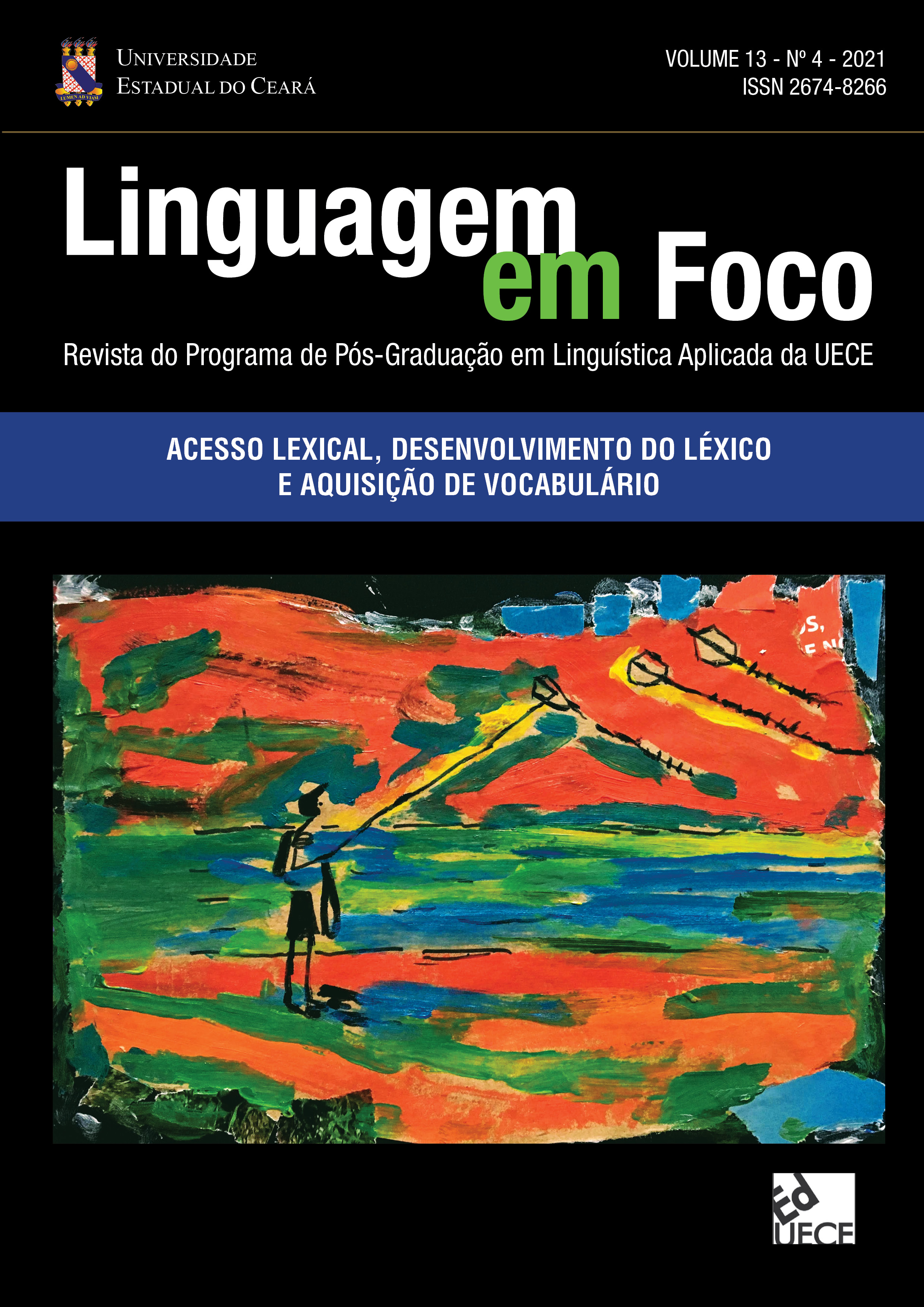Acesso Lexical na Leitura
Síntese de achados a partir de estudos de rastreamento ocular e suas implicações para a alfabetização
DOI :
https://doi.org/10.46230/2674-8266-13-7433Mots-clés :
Leitura, Reconhecimento visual das palavras, Rastreador Ocular, Modelo de Dupla Rota em Cascata, Modelo Iterativo de PercepçãoRésumé
Este artigo tem como objetivo apresentar o reconhecimento visual da palavra e o acesso lexical na leitura, descrevendo as etapas desse processo e integrando o conhecimento proveniente de estudos da Psicologia Cognitiva (modelos que explicam o processamento de leitura de palavras) e da Psicolinguística (que avaliam as variáveis linguísticas que afetam o processamento lexical), focalizando os achados obtidos por meio da técnica de rastreamento ocular. As etapas de reconhecimento da informação gráfica (processamento ortográfico) bem como o acesso aos aspectos fonológico, morfológico e semântico do processamento da palavra são sintetizado e discutido. Pretende-se que esta síntese, que inclui exemplos e esquemas gráficos, possa facilitar o acesso dessa informação por educadores envolvidos na alfabetização. O artigo traz os processos cognitivos que leitores proficientes usam a fim de reconhecer e pronunciar palavras individualmente. Ele contempla primeiramente o trabalho dos olhos durante a leitura, focando nas palavras de uma sentença, e a relação do movimento ocular com a materialidade linguística, além de especificar como o rastreador ocular registra o comportamento dos olhos. Em seguida discorre sobre os processos sublexicais e lexicais do processamento da palavra, apresentando dois modelos teóricos (Modelo Iterativo de Percepção e o Modelo de Dupla Rota em Cascata.), até a integração da palavra à sentença e ao discurso.
Téléchargements
Références
ANDREWS, S. e REICHLE, E. The Cognitive Archtecture of Reading: The Organization of na Acquired Skill. In: (Orgs.). Hagoort, P., Beckmann, C., Fisher, S., Kidd, E., Levinson, S. Human language: From genes and brains to behavior. Cambridge, MA: The MIT Press, 2019, p. 51-66.
ANDREWS, S. e VELDRE, A. What is the most plausible account of para foveal processing in reading? Language Linguist Compass. V. 13, 2019, p. 1-25.
ANDREWS, S. Individual differences in skilled visual recognition and reading. The role of lexical quality. In: Adelman, J. (Org.). Visual word recognition: Meaning and context, individuals and development. Psychology Press, 2012, p. 151–172.
ANDREWS, S.; VELDRE, A.; Clarke, I. Measuring Lexical Quality: The Role of Spelling Ability. Behavior Research Methods, 2020.
Ashby, J. e Clifton, C., Jr. The prosodic property of lexical stress affects eye movements during silent reading. Cognition, 96, 2005, p. 89-100.
BAGNO, M. Dramática da língua portuguesa. Tradição Gramatical, Mídia e Exclusão Social. São Paulo: Edições Loyola. 2005.
Caravolas, M. e Samara, A. Learning to Read and Spell Words in Different Writing Systems. In: POLLATSSEK, A. e TREIMAN, R. (Orgs). Oxford Handbook of Reading. Oxford: Oxford University Press. 2015, p. 323-343.
Chomsky, N. Language and Mind. New York, NY: Harcourt Brace Jovanovich, 1972.
Coltheart, M., Rastle, K., Perry, C., Langdon, R., & Ziegler, J. DRC: A dual route cascaded model of visual word recognition and reading aloud. Psychological Review, v. 108, n. 1, 2001, p. 204–256.
COLTHEART. M., DAVELAAR. E., JONASSON, J., BESNER, D. Access to the Internal Lexicon. In S. Dornic (Org.), Attention and performance VI. Hillsdale, N.J: Lawrence Erlbaum, 1977.
CORTESE, M. e BALOTA, D. Visual Word Recognition in Skilled Adult Readers. In: Spivey, M., McRae, K., Joanisse, M. (Orgs). The Cambridge Handbook of Psycholinguistics. Cambridge: Cambridge University Press, 2012, p. 159-185.
DAWSON, N., RASTLE, K., RICKETTS, J. Finding the man amongst many: A developmental perspective on mechanisms of morphological decomposition. Cognition. v. 211, p. 1-15, 2021. Disponível em https://www.sciencedirect.com/science/article/pii/ S001002772100024X?via%3Dihub. Acesso em 30 nov. 21.
DICASDAMAIA. Disponível em https://dicasdamaia.com.br/2018/03/05/homonimos-perfeitos/<. Acesso em 31 jan. 22.
DICIONÁRIO MERRIAM-WEBSTER ONLINE. Disponível em https://www.merriam-webster.com/. Acesso em 21 jan. 22.
DIJKSTRA, T. et al. Multilink: a computational model for bilingual word recognition and word translation. Bilingualism: Language and Cognition. V. 22, n. 4, 2019, p. 657-679.
DUBOIS, D. et al. Lexical access and vocabulary development in very young bilinguals. The international journal of bilingualism. v. 17, n. 1, p. 57-70, 2021. Disponível em https:// doi.org/10.1177/ 1367006911431198. Acesso em 30 nov. 21.
Foster, R. “Eye-tracking in psycholinguistic research.” DELTA. vol.33, n.2, 2017, 609-644. Disponível em https://doi.org/10.1590/0102-445095461720767529. Acesso em 30/NOV/21.
GOODREAD. Disponível em https://www.goodreads.com/book/show/6706905-speeches-and-letters-of-abraham-lincoln-1832-1865. Acesso em 30 nov. 21.
GOOGLE. Disponível em https://www.google.com/search?q=foveal+avascular+ zone&tbm=isch&ved=2ahUKEwjO3bj52sP1AhV3qJUCHRnjD6UQ2-cCegQIABAA&oq =foveal+zone&gs_lcp=CgNpbWcQARgAMgYIABAIEB4yBggAEAgQHjIGCAAQCBAeMgYIABAIEB4yBggAEAgQHjoHCCMQ7wMQJzoFCAAQgAQ6BAgAEEM6CwgAEIAEELEDEIMBOggIABCABBCxAzoECAAQE1DwC1jlOmCoxQFoAHAAeACAAYsBiAGSCpIBBDIuMTCYAQCgAQGqAQtnd3Mtd2l6LWltZ8ABAQ&sclient=img&ei=KBvrYc6pPPfQ1sQPmca_qAo&bih=577&biw=1229&rlz=1C1ISCS_pt-PTBR973BR973#imgrc= OtNIPIbKXmerQM. Acesso em 31 jan. 22.
HOHENSTEIN, S.; KLIEGL, R. Semantic preview benefit during reading. Journal of Experimental Psychology: Learning, Memory, and Cognition, v. 40, n. 1, p. 166-190, 2014.
HUANG, Y. Pragmatics. Nova York: Oxford University Press, 2007.
INAF. “Estudo Especial sobre Alfabetismo e Mundo do Trabalho”, 2016. Disponível em https://acaoeducativa.org.br/wp-content/uploads/2016/09 /INAFEstudosEspeciais_2016_ Letramento_e_Mundo_do_Trabalho.pdf. Acesso em 20 nov. 21.
JUST, M. e CARPENTER, P. Tsks effects on eye movements during reading. Journal of Experimental Psychology: Learning, Memory and Cognition, v. 36, 1980, p-1561-1566.
KESSLER, B. e TREIMAN.R. Writing Systems: Their Properties and Implications for Reading. In: POLLATSSEK, A. e TREIMAN, R. (Orgs). Oxford Handbook of Reading. Oxford: Oxford University Press. 2015, p.10-25.
LORANDI, A. Formas morfológicas variantes na aquisição da morfologia: evidências da sensibilidade da criança à gramática da língua. Letrônica v. 3, n. 1, 2010, p. 81-96.
MARTIN, Ethel. Saccadic suppression: A review. Psychological Bulletin, v. 81, n. 12, 1974, p. 899-917.
McCLELLAND, J. e RUMELHART, D. An interactive activation model of context effects in letter perception. Part 1. An Account of basic findings. Psychological Review, v. 88, 1981, p. 375-407.
NOBRE, A. e SALLES, J. O papel do processamento léxico-semântico em modelos de leitura. Arquivos Brasileiros de Psicologia. Rio de Janeiro. v. 66, n. 2, p. 128-142, 2014. Disponível em http://pepsic.bvsalud.org/pdf/arbp/v66n2/10.pdf. Acesso em 30 nov. 21.
O Globo. Cérebro vê palavras conhecidas como imagens. Saúde. Ciência. Disponível em https://oglobo.globo.com/saude/ciencia/cerebro-ve-palavras-conhecidas-como-imagens-15686593. Acesso em 30 nov. 21.
PERFETTI, Charles A. Lexical Quality revisited. In SEGERS, E.; VAN DEN BROEK, P. (Orgs). Developmental Perspectives in Written Language and Literacy: In Honor to Ludo Verhoeven, Amsterdam: John Benjamin Publishing Company, 2017.
PERFETTI, Charles A., Reading ability: Lexical quality to comprehension. Scientific Studies of Reading. v.11, n. 4, p. 357-383, 2007.
PERFETTI, Charles A.; HART, Leslie. (2002). The lexical quality hypothesis. In L. Verhoeven, C. Elbro & P. Reitsma (Org.) Precursors of functional literacy. Amsterdam, The Netherlands: John Benjamins Publishing, 2002, p 189-213.
POLLATSEK, A. MILLER, B. Reading and Writing. Introductory to Special Issue on Writing Article. Read Writ. V. 24, 2011. Disponível em https://link.springer.com/article/ 10.1007/s11145-010-9268-5#citeas. Acesso em 30 nov. 21.
PROVA BRASIL, Disponível em https://qedu.org.br/brasil/aprendizado. Acesso em 31 jan. 22.
Rastle, K. e Davis, M. Morphological decomposition based on the analysis of orthography. Language and Cognitive Processes, v. 23, n.7 e 8, 2008, p. 942-971.
Rastle, K. The place of morphology in learning to read in English. Cortex. Vol. 116, p. 45-54, 2019. Disponível em https://www.sciencedirect.com/science/article/pii/ S0010945218300571. Acesso em 30 nov. 21.
Rastle, K. Visual Word Recognition. In: Hickok,G. e Small, S. (Orgs.) Neurobiology of Language. Londres: Academic Press, 2016, p. 255-264.
Rastle, K. Visual Word Recognition. In: Rueschemeyer e Gaskell (Org.) The Oxford Handbook of Psycholinguistics. 2a. ed. Oxford: Oxford University Press. 2007, p. 71-87.
Rastle, K., Davis, M., New, B. The broth in my brother’s brothel: Morpho-orthographic segmentation in visual word recognition. Psychonomic Bulletin & Review, v.11, n. 6, 2004, p. 1090-1098.
Rayner, K. Eye movements and perceptual span in beginning and skilled readers. Journal of Experimental Child Psychology. v. 41, 1986, p. 211–236.
Rayner, K. The gaze-contingent moving window in reading: Development and review. Visual. Cognition, v. 22, 2014, p. 242–258.
RAYNER, Keith. Eye movements in reading and information processing: 20 years of research. Psychological Bulletin, v.124, n. 1, 1998, p. 372-422.
SCHERRE, M. Contra-Capa. In: BAGNO, M. Dramática da língua portuguesa. Tradição Gramatical, Mídia e Exclusão Social. São Paulo: Edições Loyola, 2005.
SCHOTTER, E. e RAYNER, K. The Work of the Eyes During Reading. In: POLLATSSEK, A. e TREIMAN, R. (Orgs). Oxford Handbook of Reading. Oxford: Oxford University Press. 2015, p. 44-59.
SCHOTTER, E. Synonyms provide semantic preview benefit in English. Journal of Memory ans Language. V. 69, 2013, np. 619-633.
SCHOTTER, E., ANGELE, B., RAYNER, K. Parafoveal Processing in Reading. Attention, Perception, & Psychophysics v. 74, 2012, p. 5–35.
Taft, M. e Ardasinski, S. Obligatory decomposition in reading prefixed words. The Mental Lexicon, v.1, 2006, p. 183-199.
TAFT, M. e FORSTER, K. Lexical storage and retrievel of prefixed words. Journal of Verbal Learning and Verbal Behavior. v.14, 1975, p. 638-647.
UNESCO. Disponível em https://en.unesco.org/themes/literacy. Acesso em 31 jan. 22.
VELDRE, A. e ANDREWS, S. Lexical quality and eye movements: Individual differences in the perceptual span of skilled adult readers. The Quarterly Journal of Experimental Psychology, v. 67, n. 4, 2014, p. 703-727.
YAP, M. e BALOTA, D. Visual Word Recognition. In: POLLATSSEK, A. e TREIMAN, R. (Orgs). Oxford Handbook of Reading. Oxford: Oxford University Press. 2015, p. 26-43.
Téléchargements
Publiée
Comment citer
Numéro
Rubrique
Licence
(c) Tous droits réservés Maria Cristina Micelli Fonseca, Katerina Lukasova, Maria Teresa Carthery-Goulart 2022

Ce travail est disponible sous la licence Creative Commons Attribution 4.0 International .
Os autores que publicam na Linguagem em Foco concordam com os seguintes termos:
- Os autores mantêm os direitos autorais e concedem à revista o direito de primeira publicação. Os artigos estão simultaneamente licenciados sob a Creative Commons Attribution License que permite a partilha do trabalho com reconhecimento da sua autoria e da publicação inicial nesta revista.
- Os conceitos emitidos em artigos assinados são de absoluta e exclusiva responsabilidade de seus autores. Para tanto, solicitamos uma Declaração de Direito Autoral, que deve ser submetido junto ao manuscrito como Documento Suplementar.
- Os autores têm autorização para disponibilizar a versão do texto publicada na Linguagem em Foco em repositórios institucionais ou outras plataformas de distribuição de trabalhos acadêmicos (ex. ResearchGate, Academia.edu).





























